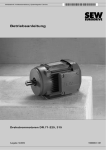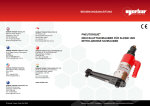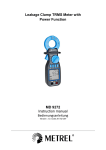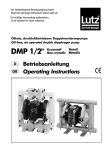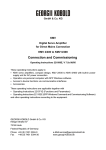Download Bedienungsanleitung Instruction manual Prescriptions de Service
Transcript
Bedienungsanleitung Instruction manual Prescriptions de Service Istruzioni per l'uso Dauermagnetbremse MB für Motoren und Drehfeldmagnete Permanent magnet brake MB for three-phase motors, torque motors Frein MB à aimant permanent pour des moteurs et des électro-aimants à champ tournant Freno magnetico permanente MB per motori e magneti a campo rotante Art.-Nr. 221008-01 Ver. 03.03 GEORGII KOBOLD GmbH & Co. KG Ihlinger Strasse 57 72160 Horb Bundesrepublik Deutschland Tel. +49 (0) 7451 5394-0 Fax +49 (0) 7451 5394-53 e-Mail [email protected] www.georgii-kobold.de Bedienungsanleitung 221008 03/03 Dauermagnetbremse MB für Motoren und Drehfeldmagnete Allgemeines Die Dauermagnet-Einscheibenbremsen MB sind für den direkten Anbau an GEORGII KOBOLD Motoren und Drehfeldmagnete konstruiert. Abmessungen, Formgebung, Luftführung, Wärmekoppelung, automatischer Verschleißausgleich und die erreichten technischen Daten machen die Antriebseinheit zu einem hochwertigen Produkt. Durch die Wirkung des Dauermagneten hat die Bremse im spannungslosen Zustand ihr volles Bremsmoment. Das Anlegen von Gleichspannung bewirkt in der Bremslüftspule ein dem Dauermagnetfeld entgegengerichtetes Elektromagnetfeld und kompensiert dieses. Eine im Teil 11 eingebaute Tellerfeder stützt sich an einem Schleppring ab und sorgt für eine vollkommene Aufhebung des Reibungsschlusses. Anschlussspannung Steht Wechselspannung zur Verfügung, erhält der Motor im Klemmenkasten einen Brückengleichrichter mit Überspannungsschutz, Teile-Nr. 044070.... Der angelegten sinusförmigen Wechselspannung entspricht eine ca. 0,9-fache Gleichspannung. Beispiel : 230V Wechselspannung ergeben ca. 200V Gleichspannung am Gleichrichterausgang. Der Gleichspannungswert ist an der Bremse aufgestempelt, während das Motorleistungsschild die Wechselspannungsangabe enthält. Steht Gleichspannung zur Verfügung, erhält der Motor im Klemmenkasten lediglich einen Überspannungsschutz je nach den Platzverhältnissen in Form einer Anschlussgarnitur 0440872.. oder eines Bauteiles 021043... Die Stempelung des Leistungsschildes entspricht der Gleichspannungsangabe auf der Bremse. Spannungstoleranz Die Bremse ist funktionsfähig, wenn die angelegte Gleichspannung innerhalb des 0,85- bis 1,1-fachen der Nenngleichspannung liegt. Schutzart Bremse MB Bremse MB../S5 Bremse MBZ lP 40 IP 40 mit nichtrostenden Ankersegmenten IP 55 Verunreinigungen an den Bremsflächen, besonders durch Fette und Öle, reduzieren das Bremsmoment. Bei Verwendung im Freien empfiehlt sich ein Schutzdach. Anbaulage Die Bremse kann in allen Lagen betrieben werden. Sehr starke Vibration und senkrechte Lage des Motors mit Abtrieb nach oben (Bauformen IM V6, IM V9 oder IM V19) können Sondermaßnahmen notwendig machen. Bitte nehmen Sie in solchen Fällen unsere Beratung in Anspruch. Anschluss Im Klemmenkasten des Motors oder Drehfeldmagneten befindet sich ein Schaltbild. Wartung Die Bremse verlangt während ihrer langen Lebensdauer keine Nachstellung. Durch die Konstruktion bedingt (luftspaltenloses Magnetsystem) reiben auch die metallischen Polflächen aufeinander und verschleißen zusammen mit dem Reibbelag. Der Verschleiß wird automatisch ausgeglichen, dadurch bleiben Lüftung und Nachlauf konstant. Der Verschleißzustand kann nach dem Abnehmen der Lüfterhaube 7 gemessen werden. Das Maß A im neuen Zustand und bei abgenütztem Bremsbelag ist in der nachfolgenden Tabelle festgehalten. Wenn aus irgendwelchen Gründen der unter »Allgemein« erwähnte Schleppring so stark auf der Welle sitzt, dass sich das Bremsmoment auffallend verringert, empfiehlt sich folgendes Vorgehen : Lüfterhaube 7 und Anschlagscheibe 5 entfernen, umlaufendes Bremsenteil 4 mittels Abziehvorrichtung abziehen bzw. durch Anlegen von Spannung die Bremse lüften und das umlaufende Bremsenteil abnehmen. Verzahnung und Welle mit Optimoly PL bestreichen und die Montage der Teile 4, 5 und 7 wieder vornehmen. Das gesamte Lüfterteil mit Nachführelement ist ein begrenzt lagerfähiges Produkt. Bei längerem Stillstand oder Einlagerung des Motors ist bei nicht nachstellendem Lüfterteil analog zu verfahren. Type K2407 KOD 3.. MB KOD 4.. MB KOD 5 MB KOD 6.. MB KOD 7.. MB KOD 8.. MB KOD 5.. MB 54 KOD 6.. MB 65 KOD 7.. MB 76 PO 5.. MB PO 6.. MB PO 7.. MB Maß A neu abgenützt 9,1 9,1 9 10,7 12,9 12,9 9,1 9 10,7 9,1 9 10,7 6 6 6 7 8 8 6 6 7 6 6 7 1 K2406 Austausch der MB-Bremse a) Lüfterhaube 7 abnehmen. b) Anschlagscheibe 5 abschrauben. c) Anschlüsse der Bremslüftspule im Klemmenkasten am Gleichrichter abklemmen. Auf Polarität (Farbe der Anschlüsse) achten ! d) Mittels Abziehvorrichtung, deren Klauen hinter dem am Lüfter befestigten Nachführelement 11 angesetzt werden, das umlaufende Bremsenteil 4 abziehen bzw. durch Anlegen von Spannung die Bremse lüften und das umlaufende Bremsenteil abnehmen. e) Befestigungsschrauben 8 lösen und das feststehende Bremsenteil abnehmen. Soll der Motor weiter demontiert werden : f) 4 Gewindebolzen bzw. Schrauben 1 (ggf. vorher Zwischenring 10) entfernen. g) Läufer 6 mit Lagerschild 2 herausnehmen. h) Nach dem Lösen des Kugellagerdeckels 9 kann das Lagerschild abgenommen werden. i) Bei der Montage in umgekehrter Reihenfolge vorgehen. Verzahnung und Wellenende - in den Schnittzeichnungen durch strichpunktierte Linien gekennzeichnet - mit Optimoly PL bestreichen ! Bitte beachten! In der Kerbverzahnung der Lüfterbohrung ist ein doppeltbreiter Zahn. Der Lüfter kann daher nur in einer Stellung auf die Welle aufgeschoben werden. Gewaltanwendung vermeiden ! Bis das volle Bremsmoment wirksam wird, können ca. 50 -100 Schaltzyklen des Bremsmotors notwendig sein. Abgenutzte Bremsen sind komplett auszutauschen. Beim Ersatz einer MA- durch eine MB-Bremse ist u. a. der Austausch des Lagerschildes erforderlich. Bitte bestellen Sie gegebenenfalls den gesamten Umbausatz. 2 Instruction manual 221008E 03/03 Permanent magnet brake MB for three-phase motors, torque motors General The permanent magnet single disc brakes MB are designed for direct mounting to GEORGII KOBOLD motors. Dimensions, shaping, cooling and heat dissipation, automatic abrasion compensation and the achieved technical data make the drive unit a superior product. For effect of the permanent magnet at the state of dead, the brake has its full braking couple. Switching on d.c. to the brake lifting coil causes a field vs. the field of the permanent magnet and is compensating it. A cup spring mounted in part 11, supported by a drag ring fully eliminates the friction contact. Connection voltage If a.c. voltage is available the terminal box of the motor is equipped with a bridge rectifier with overvoltage protection, part no. 044070... An approx. 0,9-times d.c. voltage corresponds to the applied sinusoidal a.c. voltage. Example: 230 V a.c, voltage results in approx. 200 V d.c. voltage at the rectifier output. The d.c. voltage value is stamped on the brake, while the motor type plate shows the a.c. voltage value. If d.c. voltage is available the terminal box of the motor is only equipped with an overvoltage protection according to the space available either in the form of a connection kit 044087Z.. or a component 021043.. The stamping of the type plate corresponds to the indication of the d.c. voltage shown on the brake. Voltage tolerance The brake operates when the applied d.c. voltage is within the range of the 0,85 to 1,1-times rated d.c. voltage. Protection Brake MB Brake MB 55 Brake MBZ IP 40 IP 40 with rust resisting armature Segments IP 55 Dirty oiled-up brake faces reduce the brake torque. If the motor operates in exposed positions, a protective cover should be fitted, but without impairing the flow of cooling air to the motor. Mounting position The brake can be operated in all mounting positions. Very strong vibration and vertical position of the motor with shaft end upwards (mounting types IM V6, IM V9 or IM V19) may require special arrangements. Please consult us in such cases. Connection See wiring diagram in the terminal box of the motor. Maintenance According to its long duration of life the brake does not need any readjustment. Since it is a gapless magnet system, the metallic pole faces rub one against the other and thus wear together with the brake lining. The wear is automatically compensated thus ensuring that the brake fully maintains its efficiency. The brake wear can be measured after removal of fan hood 7. Dimension "A" in new and worn out condition of the brake lining is shown in the table below. If for any reasons the drag ring mentioned under "general" adheres so much to the shaft that the brake torque decreases remarkably, proceed as follows: Remove fan hood 7 and stop disc 5 as well as the rotating part of the brake 4 by using a pulley extracting tool, resp. lift the brake by applying voltage and remove the rotating part of the brake, apply "0ptimoly PL" grease to the splined shaft end and mount parts 4, 5 and 7 again. The entire fan section with follow-up element is a product that can be stocked for a limited period only. Proceed analogously for a non-regulating fan section in the case of longer standstill or storage of the motor. Type KOD 3.. MB KOD 4.. MB KOD 5 MB KOD 6.. MB KOD 7.. MB KOD 8.. MB KOD 5.. MB 54 KOD 6.. MB 65 KOD 7.. MB 76 PO 5.. MB PO 6.. MB PO 7.. MB Dimension "A" new worn out 9,1 9,1 9 10,7 12,9 12,9 9,1 9 10,7 9,1 9 10,7 6 6 6 7 8 8 6 6 7 6 6 7 K2407 3 K2406 Replacement of the MB-brake a) Remove fan hood 7 b) Unscrew stop disc 5 c) Disconnect brake lift coil terminals in the terminal box from the rectifier. Watch polarity (lead colours)! d) Remove the rotating Part of the brake 4 by using a pulley extracting tool, the claws of which should be applied behind the adjusting device 11 fixed to the fan, resp. lift the brake by applying voltage and remove the rotating part of the brake. e) Unscrew fixing screws 8 and remove stationary part of the brake. If the motor is required to be dismantled further, proceed as follows: f) Remove 4 threaded bolts, resp. screws 1 (at first possibly intermediate ring 10). g) Remove rotor 6 with endshield 2. h) Remove endshield after removal of bearing retaining plate 9. i) Assemble in reverse order, apply before "Optimoly PL" grease to the splined shaft end as shown in the above sectional drawing! Please note! There is only one position for pushing the fan back on the shaft as the double tooth has to be carefully engaged into the double space on the serrated shaft. - Avoid to employ any force! Approx. 50 to 100 switching cycles of the brake motor are necessary until the full brake torque becomes efficient. Worn brakes should be replaced by a complete new assembly. When a MA-brake is replaced by a MB-brake the endshield has to be exchanged too! Please possibly order the whole conversion kit. 4 Prescriptions de Service 221008F 03/03 Frein MB à aimant permanent pour des moteurs et des électro-aimants à champ tournant Généralités Tension de raccordement Tolérance de tension Protection Position de montage Raccordement Entretien Les freins monodisques MB actionnés par aimant permanent ont été conçus pour montage directe à des moteurs et des électro-aimants à champ tournant GEORGII KOBOLD. Dimensions, façonnage, ventilation et dissipation de chaleur, compensation automatique de l'usure et les données techniques rendent l'unité d'entraînement un produit supérieur. Par attraction de l'aimant permanent, le frein est toujours serré quand le moteur est déclenché. Pour libérer le frein, il suffit d'appliquer la tension fournie par un redresseur sur la bobine dans la partie fixe du frein. Cette dernière produit ou champ magnétique opposé à celui de l'aimant permanent, se trouvant aussi dans la partie fixe du frein derrière la bobine, et le neutralise. Un ressort de dégagement qui s'appuie sur une bague adhérente située sur l'arbre du moteur repousse la partie rotative du frein, joint avec l'arbre par une cannelure, de telle sorte, que tout frottement soit éliminé et permet ainsi du moteur de démarrer librement. Il est admissible de déserrer le frein en permanence, lorsque le moteur est arrêté. Si tension alternative est disponible, la boîte à bornes du moteur est équipée d'un redresseur en pont, pièce no. 044070.... avec protection contre les surtensions. Une tension continue d'environ 0,9 fois autant correspond à la tension alternative sinusoidale appliquée. Exemple: 230 V tension alternative résultent en env. 200 V tension continue à la sortie du redresseur. La valeur de la tension continue est marquée sur le frein, tandis que la plaque signalétique du moteur montre la tension alternative. Si tension continue est disponible, la boîte à bornes du moteur est seulement équipée d'une protection contre les surtensions selon l'espace disponible sous forme d'une garniture de raccordement 044087Z.. ou d'une pièce 021043... La plaque signalétique du moteur montre la tension continue indiquée sur le frein. Le frein fonctionne, si la tension continue appliquée est dans la gamme de 0,85 à 1,1 fois autant la tension continue nominale. frein MB IP40 frein MB..S5 IP40 avec des segments d'induit inoxydables frein MBZ IP55 Des pollutions, spécialement de graisse ou d'huile, sur les garnitures du frein réduisent le couple de freinage. Lors de montage en plein-air, prévoir ou toît de protection. Le frein est indifférent à son position de montage. Très forte vibration et position verticale du moteur avec bout d'arbre vers le haut (formes de fixation IM V6, IM V9) peuvent rendre nécessaire des mesures spéciales. Veuillez nous consulter dans de tels cas. Voir schémas de connexion dans la boîte à bornes du moteur ou de l'électro-aimant à champ tournant. Le frein ne nécessite aucun réglage pendant sa très longue durée de vie. Sa construction spéciale (sans entrefer) nécessite un frottement et une usure des anneaux de pôles créant ainsi des rainures dans les garnitures du frein. L'usure est compensée automatiquement, de sorte que les caractéristiques de freinage restent constantes pendant toute sa durée de vie. Après avoir enlevé le capot de ventilateur 7, l'état d'usure peut être mesuré. La dimension A en état neuf et avec garniture de frein usé est indiquée dans la tabelle ci-dessous. Si, pour des raisons quelconques, la bague adhérente décrite sous "Généralités" adhère à l'arbre tellement que le couple de freinage diminue d'une manière frappante, procéder comme suit: Enlever le capot de ventilateur 7 et la rondelle butée 5, retirer la partie rotative du frein 4 au moyen d'un extracteur, resp. libérer le frein par application de tension et retirer la partie rotative du frein. Graisser la cannelure et l'arbre à 0ptimoly PL et remonter les pièces 4, 5 et 7. L’unité de ventilateur complète avec élément d’asservissement est un produit entreposable pour une durée limitée. En cas d’immobilisation prolongée ou d’emmagasinage du moteur, procéder de façon analogue pour l’unité de ventilateur non compensatrice. Type K2407 KOD 3.. MB KOD 4.. MB KOD 5 MB KOD 6.. MB KOD 7.. MB KOD 8.. MB KOD 5.. MB 54 KOD 6.. MB 65 KOD 7.. MB 76 PO 5.. MB PO 6.. MB PO 7.. MB Dimension A neuf usé 9,1 9,1 9 10,7 12,9 12,9 9,1 9 10,7 9,1 9 10,7 6 6 6 7 8 8 6 6 7 6 6 7 5 K2406 Remplacement du frein MB a) Enlever le capot de ventilateur 7. b) Dévisser la rondelle butée 5. c) Déconnecter la bobine de frein dans la boîte à bornes du redresseur. Faire attention à la polarité (couleur des raccordements)! d) Retirer la partie rotative du frein 4 au moyen d'un extracteur dont les griffes sont à placer derrière l'élément d'ajustage 11, vissé au ventilateur, ou libérer le frein par application de tension et retirer la partie rotative du frein. e) Dévisser les vis de fixation 8 et enlever la partie fixe du frein. f) Enlever les 4 tiges filetées 1 (le cas échéant enlever l'anneau intermédiaire 10 au préalable). g) Retirer le rotor 6 avec la flasque-palier 2. h) Après avoir libéré le couvercle de roulement á billes 9, le flasque-palier peut être enlevé. i) Lors du montage procéder en ordre inverse. Graisser la cannelure et le bout d'arbre - marqués dans les vues en coupe par des traits mixtes - à Optimoly PL. Attention! Dans la cannelure du forage de ventilateur se trouve une dent a largeur double de telle sorte que le ventilateur ne peut être glissé sur l'arbre que dans une seule position. Eviter l'emploi de la force! Env. 50 à 100 cycles d'opération sont nécessaires jusqu'à le couple de freinage plein devient efficace. Des freins usés doivent être remplacés complètement. Si un frein du type MA est remplacé par un frein du type MB, le flasque-palier doit être reimlacé entre autres. Le cas échéant commander le jeu de modification complet s.v.p. 6 Istruzioni per l'uso 221008I 03/03 Freno magnetico permanente MB per motori e magneti a campo rotante In generale I freni monodisco a magnete permanente MB sono costruiti per il montaggio diretto su motori e magneti a campo rotante GEORGII KOBOLD. Dimensioni, foggiatura, conduzione d'aria, accoppiamento termico, compensazione automatica dell'usura e i dati tecnici raggiunti fanno di questo gruppo azionatore un prodotto di elevato pregio. In assenza di tensione il freno possiede la sua piena coppia di frenatura mediante l'azione del magnete permanente. Applicando tensione continua si provoca nell'avvolgimento d'allentamento del freno un controcampo elettromagnetico nei confronti del campo magnetico permanente, compensandolo. Un molla a tazza incorporata nel pezzo 11 va ad appoggiarsi su un anello di trascinamento, provocando un completo annullamento del blocco da attrito. Tensione di allacciamento Se vi è a disposizione una tensione alternata, al motore si applicherà nella scatola dei morsetti un raddrizzatore a ponte con protezione di sovratensione, Nr. del pezzo 044070....La tensione alternata sinusoidale applicata corrisponde a 0,9 volte la tensione continua risultante. Esempio : 230V di tensione alternata forniscono ca. 200V di tensione continua. Il valore di tensione continua è timbrato sul freno, mentre la targhetta di potenza del motore riporta il valore della tensione alternata. Se vi è a disposizione tensione continua , il motore verrà corredato nella scatola dei morsetti solamente di una protezione contro le sovratensioni, a seconda dello spazio a disposizione, sotto forma della componente da attaccarsi 0440872.. oppure del pezzo d'accessorio 021043... La timbratura sulla targhetta di potenza corrisponde all'indicazione di tensione continua sul freno. Tolleranza di tensione Il freno è funzionante quando la tensione continua applicata si venga a trovare tra le 0,85 e le 1,1 volte la tensione continua nominale. Tipo di protezione freno MB freno MB../S5 freno MBZ lP 40 IP 40 con segmenti d'indotto inossidabili IP 55 Imbrattamenti sulle superfici frenanti, in particolare da grasso e da olio, riducono la coppia di frenatura. Nell'impiego all'aperto si consiglia una tettoia di protezione. Posizione di montaggio Il freno può venir fatto funzionare in tutte le posizioni. Un'elevata vibrazione e la posizione verticale del motore con la presa di forza in alto (modelli IM V6, IM V9 e IM V19) possono rendere necessarie misure speciali. In casi del genere si prega di usufruire della ns. consulenza. Attacco Nella scatola dei morsetti del motore o dei magneti a campo rotante si trova uno schema dei circuiti. Manutenzione Il freno non richiede post-registrazioni nel corso della sua lunga durata di vita. In dipendenza dalla sua costruzione (sistema magnetico senza intraferro) sfregano tra loro anche le superfici metalliche dei poli, consumandosi assieme con lo strato di attrito. Il logorio viene compensato automaticamente, con ciò rimangono costanti sia allentamento che incidenza. Lo stato di usura può venir misurato, togliendo la calotta del ventilatore 7. La misura A a freno nuovo e a ferodo del freno consumato viene fissata nella seguente tabella. Quando, per una qualsiasi ragione, l'anello di trascinamento menzionato al punto "In generale" vada ad appoggiarsi sull'albero in maniera così forte, che la coppia di frenatura si riduca in modo molto evidente, si consiglia il seguente procedimento: togliere la vite del ventilatore 7 e il disco di battuta 5, mediante un dispositivo di estrazione cavare la parte rotante del freno 4 oppure, applicando la tensione, allentare il freno, togliendone la parte rotante dello stesso. Spalmare con Optimoly PL sia la dentatura che l'albero, rimontando, indi, i pezzi 4, 5 e 7. L'intera unità di ventilazione con elemento di allineamento può restare inutilizzata soltanto per un periodo di tempo limitato. In caso di soste più lunghe o immagazzinaggio del motore, procedere come in precedenza se l'unità di ventilazione non si registra. Tipo Misura “A” nuovo K2407 KOD 3.. MB KOD 4.. MB KOD 5 MB KOD 6.. MB KOD 7.. MB KOD 8.. MB KOD 5.. MB 54 KOD 6.. MB 65 KOD 7.. MB 76 PO 5.. MB PO 6.. MB PO 7.. MB 9,1 9,1 9 10,7 12,9 12,9 9,1 9 10,7 9,1 9 10,7 consumato 6 6 6 7 8 8 6 6 7 6 6 7 7 K2406 Sostituzione del freno MB a) Togliere la calotta del ventilatore 7. b) Svitare il disco di battuta 5. c) Staccare gli attacchi dell'avvolgimento di allentamento del freno sul raddrizzatore nella scatola die morsetti. Fare attenzione alla polarità (colore degli attacchi) ! d) Mediante l'estrattore, i denti del quale vanno innestati sull'elemento di guida 11 fissato dietro il ventilatore, togliere la parte rotante del freno 4 e, applicando la corrente, allentare il freno per estrarne la parte rotante dello stesso. e) Allentare le viti di fissaggio 8 , togliendo, indi, la parte fissa del freno. Se si deve smontare il motore: f) Togliere i 4 bulloni o le viti 1 (nei dovuti casi va tolto prima l'anello intermedio 10). g) Togliere il rotore 6 con lo scudo del cuscinetto 2. h) Dopo aver allentato il cappello del cuscinetto a sfere 9, può venir tolto lo scudo dello stesso. i) Nel montaggio procedere nella sequenza inversa. Spalmare con Optimoly PL sia la dentatura che l'estremità dell'albero - contrassegnate nel disegno in sezione mediante una linea tratteggiata - ! Si prega di osservare! Nel profilo a denti triangolari del foro del ventilatore vi è un dente doppio. Pertanto il ventilatore potrà venire inserito sull'albero solo in una determinata posizione. Evitare un innesto forzato ! Fino alla completa attività della coppia di frenatura, sono necessari ca. 50 - 100 cicli del motore con freno. Freni consumati vanno sostituiti completi. Nella sostituzione di un freno MA con un freno MB è necesseria anche la sostituzione dello scudo del cuscinetto. Nei dovuti casi si prega di ordinare l'intera serie del ricambio. 8













